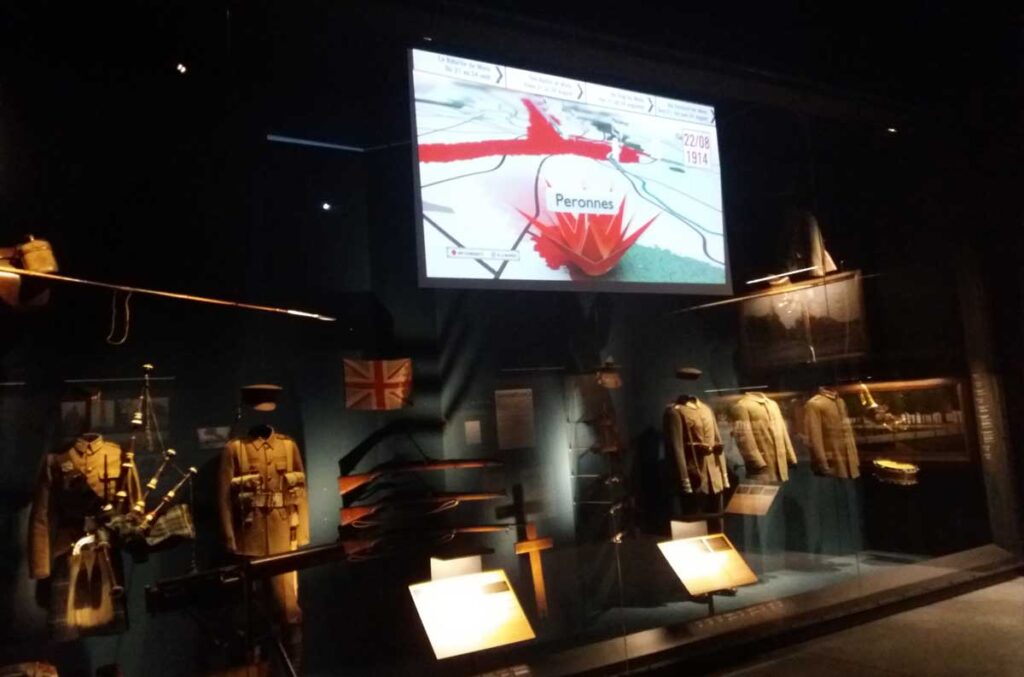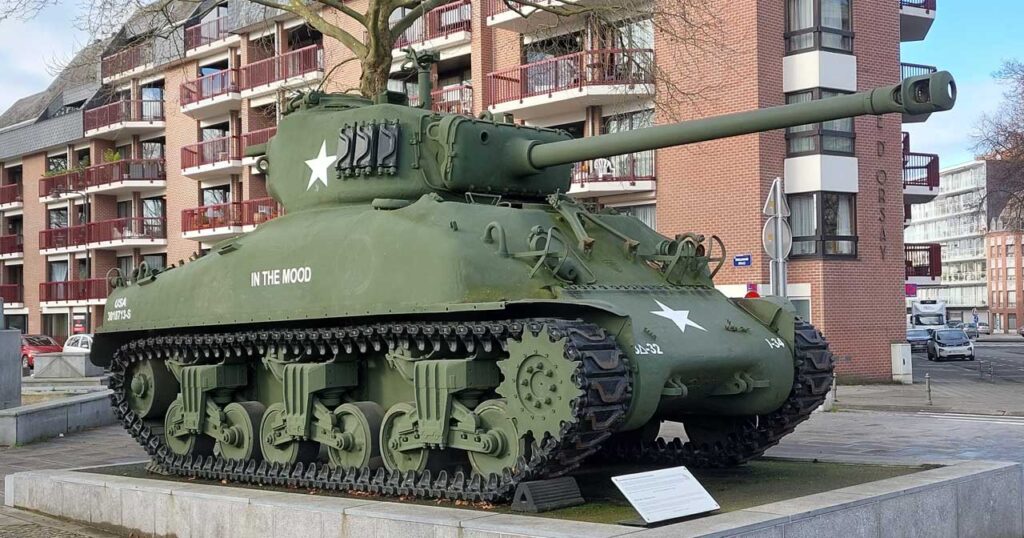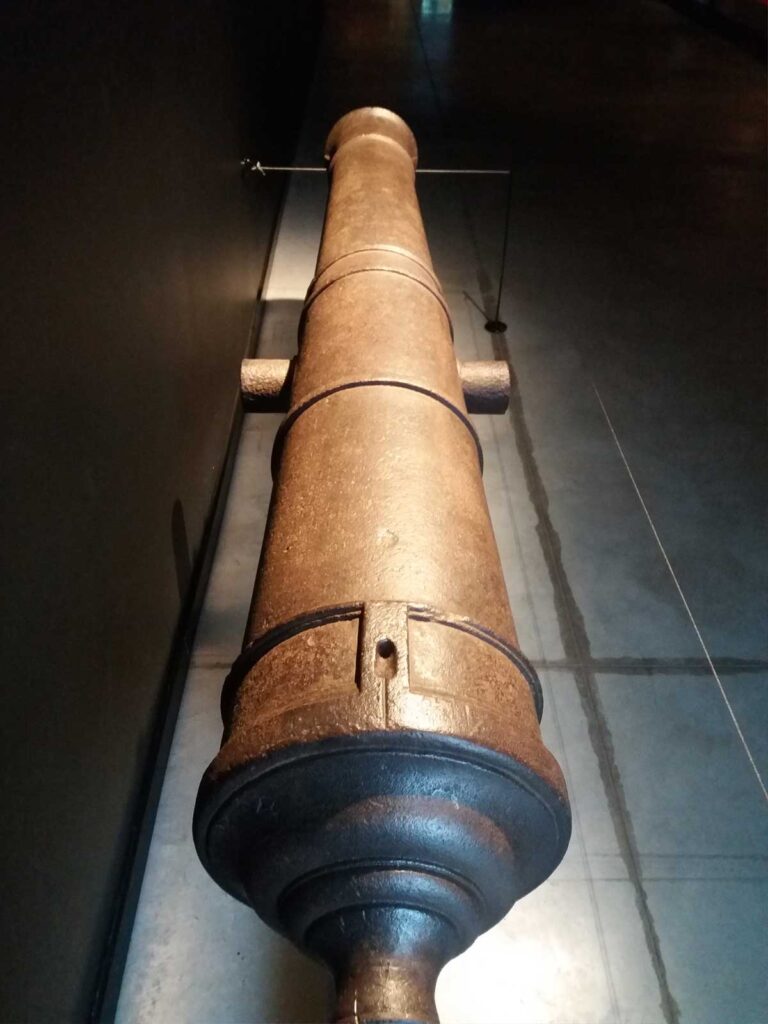All you need to know is how to visit the Mons Memorial Museum and get some advice on how to visit this wonderful war museum.
More than a simple museum, The Mons Memorial Museum is a return to the past, thanks to a magnificent collection of war objects very well highlighted, from the Middle age to the XX century.

Mons Memorial Museum
To get there, it’s easy, 10 minutes on foot from the Grand Place for example. Small road signs show you the way. If you don’t see the signs, just look around for a famous fast-food venue, on its left take the ‘rue de la clef’. From there continue down to the fish market (marché aux Poissons) by the ‘rue de la Halle’. Arrived at the bottom, go to the left towards the boulevard and look for a Sherman tank (+/- 100 meters). Head towards this armoured vehicle.
The entrance is in the large building with a huge picture window, formerly the water machine.

History of the building where the Mons Memorial Museum is:
As early as 1871, the Water Machine provided drinking water throughout the city of Mons. This water distribution network was among the largest in Belgium. In 1961, the authorities dismantled the machine during the second diversion from the river “La Trouille” and decommissioned the site in 1974. In 2015, this site became the headquarters of the new Military History Interpretation Center of Mons, namely the Mons Memorial Museum.
The Mons Memorial Museum
is a military museum with exhibitions of wars and battles that involved the city of Mons. The museum has a large and varied collection of uniforms, weapons and small objects from the Middle Ages to the 20th century. Although pre-modern conflicts are covered, special emphasis is placed on the two world wars, so devastating for Belgium. The museum’s account is fairly well documented with testimonies from civilians and soldiers on both sides of these conflicts.

The visit begins in chronological order of the periods and events of Mons’s history.
When the city becomes the target of various occupations:
– From May 1572 with the Protestant takeover by Louis de Nassau, who had hoped to pave the way for the French Protestant leader Gaspard de Coligny to oppose Spanish domination.
– In April 1691, after a nine months siege, the army of Louis XIV stormed the city
– From 1697 to 1701, Mons was alternately French or Austrian. After being under French control from 1701 to 1709, the Dutch army took over during the Battle of Malplaquet.
– In 1715, Mons returned to Austria under the terms of the Treaty of Utrecht But the French did not give up easily.
– Louis XV besieged the city again in 1746. After the Battle of Jemappes (1792), the Hainaut area was annexed to France.
The First World War
– On August 23 and 24 of the year 1914, Mons was the site of the Battle of Mons, the first battle fought by the British army during the First World War.
A small comment on a legend:
The Angels of Mons is a popular legend about a group of angels who allegedly protected members of the British army during the Battle of Mons at the start of the First World War.


– The Shadow War in an occupied country: Some occupied choose patriotism to fight in the shade against the Germans
– The liberation of Mons
The Second World War
– The Second World War and the surrender of the Belgian army as well as the case of Léopold III
– The Normandy landings bring a wind of hope among the population
-The liberation, Is it the end of the war? As a result, the German soldiers retreat back beyond the French border.
As soon as you enter the museum,
you are immersed in the heart of the conflicts. Muffled atmosphere, black walls, dim lighting and sounds of war diffused by a very good audio system.
There is a lot to see and learn, thanks to a very good arrangement of objects throughout the visit. You can watch infographics and discover paintings, posters, photos and letters … from times. Some of the pieces are highlighted in an original way, such as replicas of Czech Hedgehogs (Tschechenigel).
Czech hedgehogs: At the time, are made of steel angles or rails between 1.5 m and 2 m long; two crossed X-shaped rails with a third resting on an angle in the crossed rails (either bolted or welded together); positioned in shallow water and anchored with concrete bases. These Czech hedgehogs were intended at the time to obstruct military advances.
You will find a lot of authentic testimonies along the alleys of the museum, the real thread running through the visit. Letters, notebooks, and interviews will bring the objects presented to life, bringing a sensitive look at the events treated. To discover human experiences, part of life, anonymous or famous destinies between occupiers and occupied, between civilians and soldiers.
Next do not hesitate to take your time and sit on the benches, or in a small movie theatre to enjoy Tv screens and other visual objects.
Then do not Forget
After the walk in the Alley, place to something more fun. The final highlight of this museum is undoubtedly the cabins, all equipped with a 360-degree virtual headset. The museum invites you to put yourself in the shoes of American GIs, Germans, the Resistance, and civilians. You need to take a closer look at the objects in display cases, you will find all of them in these short movies.
In addition: a new Exhibition “From the Count’s Castle to the provincial command, ten centuries of military presence in Mons”
From the Middle Ages to today, Mons has been occupied by men-at-arms. While serving the county of Hainaut, the kingdoms of Spain or the Netherlands, or even our current Defence, these soldiers marked the landscape of Mons and actively participated in the life of the city of Doudou until today. today. In this exhibition created by young historians, you will discover these little-known facets of Mons military history from the creation of the Château Comtal in the 9th century to the actions of the military command of the Province of Hainaut in 2022.
From 11/02/2023 at 10Am to 13/08/2023 at 6PM
In conclusion, We will recommend staying a minimum of 2 hours to visit the entire complex.
Share your personal visit in the comments section bellow
Opening Hours:
Mon: closed. Tue to Sun: 10 Am – 6 Pm
Website: Memorial Museum
Prices:
Full price: 9€
Concessions: 6€
Children: 2€
Families: 3€
Combined price list museum + expo: 12€ / 8€
The Mons Memorial Museum is a museum located in the city of Mons, Belgium. It is dedicated to the history of wars in the area and especially about the two World Wars and their impact on the city and its people.
The museum has a large collection of artefacts, documents, and multimedia exhibits that provide a comprehensive look at the history of Mons during both World Wars. In addition, visitors can see military equipment, uniforms, weapons, and personal belongings of soldiers and civilians. The museum also features interactive exhibits, films and educational programs
Yes, the museum offers educational programs and workshops for children of different ages, as well as interactive exhibits that make learning about history fun and engaging.
The admission fee varies depending on age and type of ticket. Discounts are available for students, seniors, and groups.
Permanent exhibitions: €9/€6*
Temporary exhibitions: €6/€4*
Combined tickets : 12€ / 8€*
The list of persons eligible for the discounted price (teachers, students, senior citizens, various discount cards) is displayed at the entrance to MMM.
+ Free entry for children under 12 years old
The museum is open from Tuesday to Sunday, from 10:00 am to 6:00 pm. It is closed on Mondays and certain holidays.
Yes, the museum has a gift shop where visitors can purchase books, postcards, and souvenirs related to the museum’s exhibits. However on our last visit, no café in the museum.







